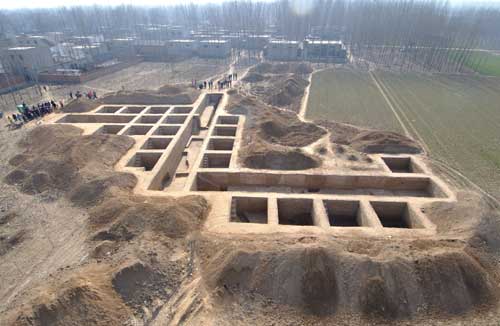A series of ritual complex are discovered within Wadian site at Yuzhou, Henan
As a part of the Chinese Civilization Exploration Project, archaeologists have discovered a series of ritual complex with symmetrical layout in a Longshan Culture Site located at Wadian, Yuzhou, Henan. Experts believed it can be regarded as the origin of an architectural style known as the “ancestor temple at the left while the altar at the right”, since the ritual complex feature with symmetrical layout is located in south of the settlements or cities.
The existing area of the Wadian site is around 1 million square meters and is a gigantic Longshan Culture site within the border of Hunan, the research of its settlement formation is a part of the Chinese Civilization Exploration Project. In recent years, the Henan Provincial Institute of Cultural Relics and Archaeology and the Peking University jointly conducted a series of work in the Wadian site, including archaeological survey, drilling, excavation, resource investigation as well as multidisciplinary research.
The northwestern terrace of the Wadian site discovered huge rounded ditches settlement site dated in late Wangwan third culture (i.e. early Xia Dynasty) of Longshan period. Its defense system was formed from three dimensions ditches (East, West and South) and Ying River in northeast.

The host of this excavation, researcher Fang Yanming from the Henan Provincial Institute of Cultural Relics and Archaeology said that the alignment of two architecture foundations from the rounded ditches discovered in the middle south was almost identical to the southern ditches. Based on the analysis of the shape, formation and inclusion of the huge rammed earth foundations located at east and west, they were the features related to the ritual activities. It might be the origin of the “ancestor temple at the left while the altar at the right” architectural style.
Among these features, the eastern huge rammed earth foundations were formed from several ditches in homocentric squares; whereas the western huge rammed earth foundations were formed by three independent architectures. One of the architectures could be the worshipping facilities known as Shan , rectangular in shape with an area around a thousand square meters, was mentioned in old literatures. Human skulls were discovered in the northwestern corner of the bedding.
Archaeologists discovered 10 human skeletons remains used for foundation laying or sacrificing. Their heads were separated with their body with either skull or limb bones. Some of these remains were a mixture between human and animal and scattered around each housing foundations.
Fang believed that the discovery of such gigantic rounded ditches and a cluster of ritual complex features describe the site properly was the central settlement in the midstream of Ying River.
From the recent archaeological excavation, a copious amount of extravagant artifacts were unearthed from Wadian site including pottery goblet, pottery head sculpture, pottery long-tailed bird, pottery with incised symbols, bird, spirals or geometric patterns. Besides, full set of wine instrument in white, black or grey pottery such as sets of wine cup, he or goblet were also identified. Moreover, several rare artifacts such as jade objects and huge bone used to practice divination were found.
Fang further explained that according to literatures, Yuzhou of Hunan was one of the major areas for activities of the Xia people since Yu and Qi period. This place was called Xia land during the ancient period. The confirmation of the central settlement of Wadian during the Longshan period and the discovery of huge rounded ditches, ritual complex features and extravagant artifacts can be connected to a literature “Yangdi of Xia, Juntai in Yuzhou”. (Translator:Li Langlin)

